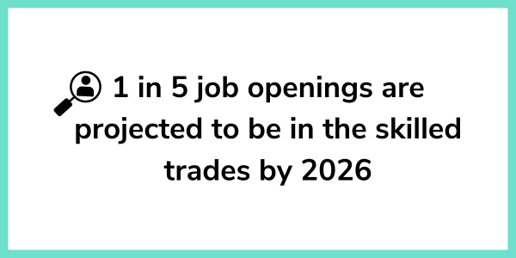Endless Possibilities in Skilled Trades
by Tanvir Kaur on 10 Apr, 2023
Have you ever walked into a building and marvelled at its beautiful interior design, or admired an infrastructure and wondered about the person who created it? Chances are, these impressive works were the result of the skilled hands of trade workers. With an estimated 700,000 skilled trades workers expected to retire between 2019 and 2028, the demand for new skilled workers is growing, and it's important to create awareness among youth about the vast career opportunities available in skilled trades.
TL; DR
Discover what skilled trades are, their benefits, and valuable resources to help students explore careers in trades.
- What are skilled trades? - Skilled trades provide a unique blend of specialized knowledge, comprehensive training, and valuable hands-on experience. From carpentry and plumbing to electrical work and automotive repair, skilled trades offer a diverse range of career opportunities that are both rewarding and challenging.
- Benefits of Skilled Trades - Skilled trades offer incredible benefits, including high job satisfaction, reasonable cost-benefit, and increasing demand in the market.
-
Resources to Explore Skilled Trades - Exploring skilled trades has never been easier, thanks to the efforts of the Government of Canada and Skills Competénces Canada in promoting skilled trades and providing resources for skilled trades awareness. Platforms such as ChatterHigh offer customized modules and courses, as well as a national competition; Let's Talk Careers which provides a fun and interactive way for students to explore various career options.
What are Skilled Trades?
A skilled trade is a type of career path that requires specialized knowledge and training, along with hands-on work experience. This industry encompasses a broad range of career options, which are further divided into major categories such as construction, transportation, manufacturing and industrial, services, and information and digital technology. There are approximately 300 skilled trades designated in Canada, and we bet most people aren’t aware of the majority of that list!
Listed below are some of the jobs that fall under the major categories of skilled trades.
|
Construction |
|
|
Transportation |
|
|
Manufacturing and Industrial |
|
|
Services |
|
|
Information and Digital Technology |
|
Benefits of Skilled Trades
High Job Satisfaction
One of the most significant benefits of skilled trades careers is the high job satisfaction they offer. Students in skilled trade programs gain paid hands-on experience, which provides an excellent opportunity to innovate and create. Skilled professions have a significant market demand, which translates into excellent job prospects and the potential for career growth.
Reasonable Cost-Benefit
Unlike traditional academic programs, skilled trades programs typically take less time to complete and require less financial investment. For example, apprenticeships allow students to earn while they learn, making it easier to cover the cost of their education.
Rising Market Demand
With the retirement of skilled trades workers and the growing demand for infrastructure, there is a huge market demand for skilled trades professionals.
For further insights into the benefits of pursuing a career in skilled trades, explore our previous blog post "5 Reasons Why Students Should Explore Careers in Skilled Trades".
Exploring Skilled Trades

The inclusion of skills trades is becoming increasingly vital to support the Canadian economy, with Ontario taking a step forward by introducing a mandatory technology credit for high school students, as reported by CBC News. This move aims to equip students with essential skills to prepare them for the evolving job market and meet the growing demand for skilled workers.
Exploring careers in skilled trades has become easier than ever with the resources available in Canada.
Skills Competénces Canada
Each year, Skills Competénces Canada hosts national and provincial competitions to present high school and post-secondary students to the world of skilled trades. These competitions offer students a better chance of making informed career decisions by providing them with more career information and insights. Moreover, students can seek guidance from career counsellors, attend career fairs, or reach out to professionals in the industry for mentorship.
Government of Canada
The Government of Canada is actively promoting skilled trades as a first-choice career path through its comprehensive website, Canada.ca/skilled-trades. This one-stop national repository provides information about over 300 skilled trades in Canada, including details about the Red Seal trade designation, in-demand trades in each region, and available financial support offered by the Government of Canada.
Carla Qualtrough, Minister of Employment, Workforce Development and Disability Inclusion, emphasizes the importance of skilled trade workers to the Canadian workforce and economy, stating,
"Canada's workforce needs more skilled trade workers. They have expertise and skills that are essential to our economy and our way of life. When Canadians are contemplating a new career, we want them to consider entering the skilled trades and to understand the exciting, well-paying opportunities that they present."
ChatterHigh
School districts can also play a crucial role in helping students explore careers in skilled trades. Customized modules or competitions with Chatterhigh, a career exploration platform, can be created to suit students' requirements and interests. Chatterhigh brings together all the necessary resources, including information from organizations like Skills Competénces Canada, to help students explore different career options.
ChatterHigh also hosts the Let's Talk Careers competition in collaboration with Let’s Talk Science, Skills Canada, NGen, NAV Canada, and Quantum AI, allowing students to win prizes while exploring different career options. Students can participate in Let's Talk Careers for free by signing up for an account on ChatterHigh's website, providing an interactive and fun way for students to learn about skilled trade careers.
The impact of the Let’s Talk Careers Competition is evident in the numbers. In the fall of 2022 alone, 453 different career paths were discovered by middle and high school students across Canada using Chatterhigh. Some examples of career titles explored by students included police officer, cook, graphic designer, electrician, plumber, and computer programmer.
To learn more about the impact of Let’s Talk Careers check out the infographic.
Conclusion
In conclusion, skilled trades provide endless possibilities for a brighter future. Students should explore these options and understand the benefits of skilled trades to make informed decisions about their future career paths. With proper guidance and resources, students can gain the skills, knowledge, and experience needed to succeed in the industry and make a valuable contribution to the Canadian economy.



